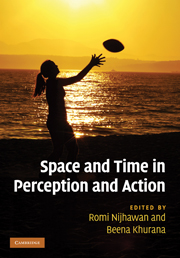Book contents
- Frontmatter
- Contents
- List of contributors
- Acknowledgments
- 1 Space and time: the fabric of thought and reality
- Part I Time–space during action: perisaccadic mislocalization and reaching
- 2 The internal eye position signal, psychophysics, and neurobiology
- 3 Factors influencing perisaccadic visual mislocalization
- 4 Visual and nonvisual factors in perisaccadic compression of space
- 5 Keeping vision stable: rapid updating of spatiotopic receptive fields may cause relativistic-like effects
- 6 Combined influences of extraretinal signals, retinal signals, and visual induction on space perception and manual behavior in perisaccadic and steady viewing
- 7 Space constancy: the rise and fall of perceptual compensation
- 8 Intercepting moving objects: do eye movements matter?
- 9 The utility of visual motion for goal-directed reaching
- Part II Temporal phenomena: perception
- Part III Temporal phenomena: binding and asynchrony
- Part IV Spatial phenomena: forward shift effects
- Part V Space–time and awareness
- Index
- References
7 - Space constancy: the rise and fall of perceptual compensation
from Part I - Time–space during action: perisaccadic mislocalization and reaching
Published online by Cambridge University Press: 05 October 2010
- Frontmatter
- Contents
- List of contributors
- Acknowledgments
- 1 Space and time: the fabric of thought and reality
- Part I Time–space during action: perisaccadic mislocalization and reaching
- 2 The internal eye position signal, psychophysics, and neurobiology
- 3 Factors influencing perisaccadic visual mislocalization
- 4 Visual and nonvisual factors in perisaccadic compression of space
- 5 Keeping vision stable: rapid updating of spatiotopic receptive fields may cause relativistic-like effects
- 6 Combined influences of extraretinal signals, retinal signals, and visual induction on space perception and manual behavior in perisaccadic and steady viewing
- 7 Space constancy: the rise and fall of perceptual compensation
- 8 Intercepting moving objects: do eye movements matter?
- 9 The utility of visual motion for goal-directed reaching
- Part II Temporal phenomena: perception
- Part III Temporal phenomena: binding and asynchrony
- Part IV Spatial phenomena: forward shift effects
- Part V Space–time and awareness
- Index
- References
Summary
Summary
Information about eye position comes from efference copy, a record of the innervation to the extraocular muscles that move the eye and proprioceptive signals from sensors in the extraocular muscles. Together they define extraretinal signals and indicate the position of the eye. By pressing on the eyelid of a viewing eye, the extraocular muscles can be activated to maintain a steady gaze position without rotation of the eye. This procedure decouples efference copy from gaze position, making it possible to measure the gain of the efference copy signal. The gain is 0.61; the gain of oculomotor proprioception, measured by a similar eye press technique, is 0.26. The two signals together sum to only 0.87, leading to the conclusion that humans underestimate the deviations of their own eyes and that extraretinal signals cannot be the mechanisms underlying space constancy (the perception that the world remains stable despite eye movements). The underregistration of eye deviation accounts quantitatively for a previously unexplained illusion of visual direction. Extraretinal signals are used in static conditions, especially for controlling motor behavior. The role of extraretinal signals during a saccade, if any, is not to compensate the previous retinal position but to destroy it. Then perception can begin with a clean slate during the next fixation interval.
- Type
- Chapter
- Information
- Space and Time in Perception and Action , pp. 94 - 108Publisher: Cambridge University PressPrint publication year: 2010
References
- 3
- Cited by



